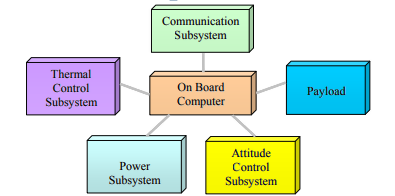The CubeSat-class Spacecraft hardware has volume, mass, and power limitations more extreme than in other satellites. In fact, the CubeSat-class spacecraft is a Cube with dimensions 10cm x 10cm x 10cm, mass one kilogram maximum and the available power is about 2Watt by mounting the solar cells on the CubeSat structure.
The CubeSat-class spacecrafts have the advantages of being able to perform as a test bed for new core space technologies to be applied to space programs, for much lower cost, shorter schedule, and less risk. For this reason, the world leaders in space technology, including the US and Europe, are focusing their efforts on smaller satellites under the motto of “Faster, Cheaper, Better” that can perform missions traditionally assigned to large/medium satellites in the past.
Satellite architecture overview
The Data Handling Subsystem is considered as an interface between the control station and the other satellite subsystems. The Data Handling Subsystem modules include communication subsystem (antennas, modulator, demodulator) and on-board computer which controls the satellite subsystems. But how these subsystems are attached to the on-board computer, two principal architectures are distinguished.

Star Architecture: The On-Board computer (OBC) must run separate data lines to each subsystem. In this architecture, the OBC should have many peripheral interfaces equal to the number of satellite subsystems on board and perhaps there will be a problem of wiring. bus Architecture in this case, all satellite subsystems are connected to a bus which is like Local Area Network (LAN) aboard the satellite. In general, we used a Master slave protocol. The three simple Master-slave bus commonly used in the embedded system are: CAN (Controller Area Network), SPI (Serial Peripheral Interface) and I²C (Inter Integrated Circuit).
CubeSat subsystems requirements
The requirements of CubeSat-class spacecrafts are significantly different from their ancestors’ conventional satellites, and new design techniques are needed to meet these evolving requirements. The unique requirements of the Telecommunication CubeSat satellite demonstrate this evolution. The design needs to be relatively inexpensive while at the same time computationally robust. It should consume limited power and must support the space environment by reducing susceptibility to radiation and thermal effects. In a previous text, we supposed that all the satellite subsystems are intelligent. i.e.; each satellite subsystem has its own microcontroller.
CubeSat satellite platform subsystems design
Space environment
An important issue to consider, which affects all electronic devices in space environment, is radiation. It can lead to various types of problems. These problems range from operational malfunctions to physical damage of the devices. CMOS technology is preferred for space applications because of its high noise margins and low static power requirements. Scaling and integration are other advances CMOS technology has over other semiconductor technologies. On the other hand, CMOS is susceptive to two types of space radiation effects caused by electrons and protons trapped by the terrestrial magnetic field: Total Ionizing Dose (TID) and Single Event Effects (SEE). TID effects are the result of accumulated exposure to ionizing radiation. SEE are the result of a single high-energy particle that strikes the device.
Data handling subsystem design
In the satellite modular architecture (Wertz & Larson, 1999), each single subsystem has a dedicated hardware and software. The Cubesat has important constraints on cost, power and mass, and especially on size. The approach that has been taken in this research consists of the integration of the maximum subsystems within the same unit considering that single subsystems can be setup without modifying the operation of the remaining subsystems. As said before, the Data Handling Subsystem...
Read more » ensafatef
ensafatef